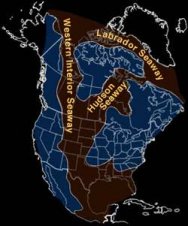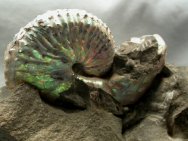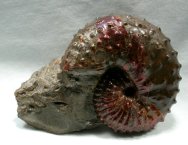Fox Hills Formation
Fossils of the Fox Hills FormationGeologic Time: Cretaceous, some 70 million years ago |
Related
Interest: Hell Creek |
| During
most of the upper Cretaceous period, the Western Interior
portion of North America was covered by a large, shallow (some
100 to 300 meters of maximal depth), epicontinental seaway.
This vast seaway stretched from the Gulf of Mexico all the
way to the Arctic Ocean. It was during the late Maastrichtian
stage that the Fox Hills Seaway retreated, leaving the Fox
Hills formation. During the Late Cretaceous, fluctuations
in the Fox Hills Formation exposures occur in south-central and southwestern North Dakota, and mostly comprise sandstones and siltstones that were deposited in shallow marine and lagoon environments. The fossil biota is enormously diverse. Including plant, cartilaginous and ray-finned fishes, land and aquatic reptiles (turtles, crocs, salamanders, mosasaurs), and dinosaurs , including Troodon formosus, the Dromaeosaurid Struthiomimus, Nodosaurids, Hadrosaurids like Edmontosaurus, and Ceratopsids like Triceratops. The vertebrates from the formation, however, are mainly known from teeth and other bones, with complete or nearly complete fossils rarely found. Despite
the faunal diversity, the Fox Hills Formation is most famous
for incredibly beautiful ammonoid fossils. The high degree
of preservation of their natural mother-of-pearl shell makes
them appear to be preserved as opal, often called ammolite.
This is a consequence of light passing through the various
layers of aragonite and conchiolin deposited by the ammonite
in life. Conchiolin is secreted by various other mollusks,
including oysters, and is a complex protein. Fox Hills Formation ammonoids normally occur in concretions, which are cracked to reveal the ammonoids (and other sea life such as bivalves). Modern-day cephalopods are known to come together for mating, only to die soon thereafter. This seems to be the reason that Fox Hills’ concretions often contains a death assemblage of ammonoids, testament to the fact that they mated together and then died together.
| ||||||||||||||||||
Fossil
Museum Navigation:
Home Geological Time Paleobiology Geological History Tree of Life Fossil Sites Fossils Evolution Fossil Record Museum Fossils |




